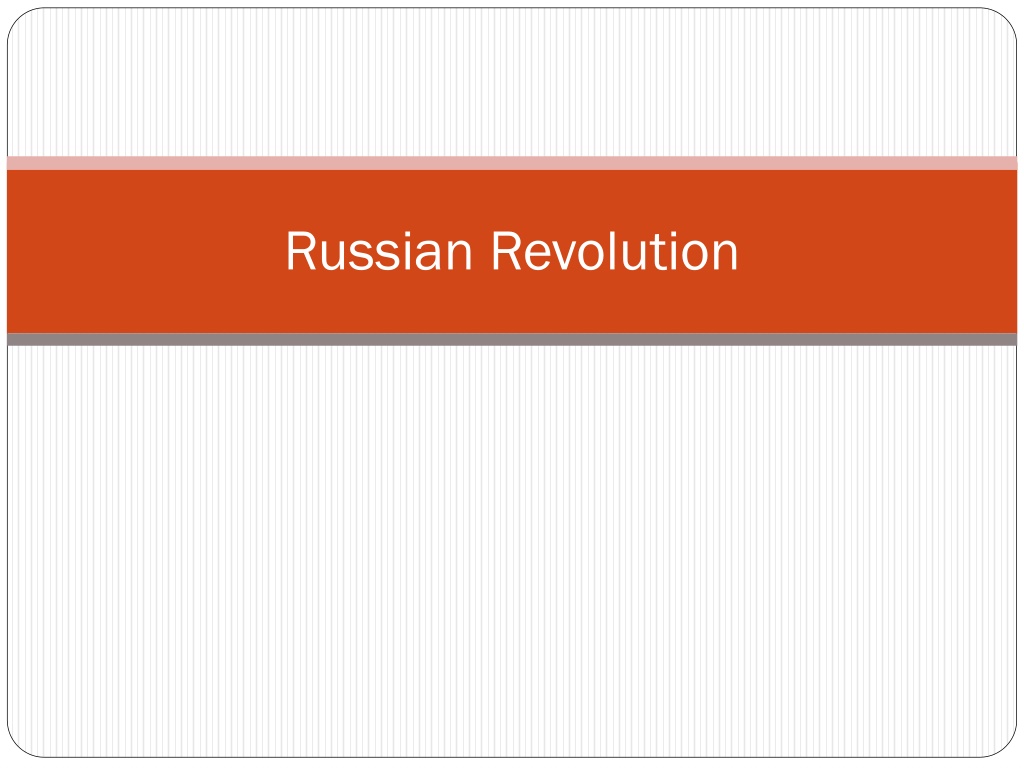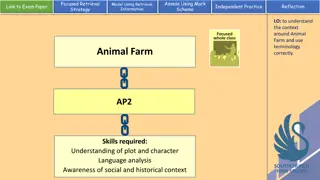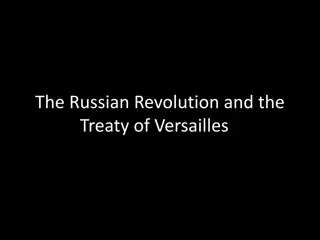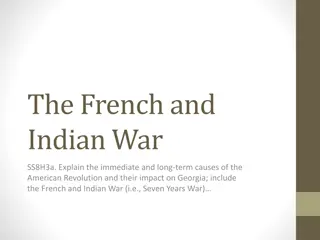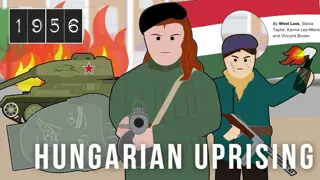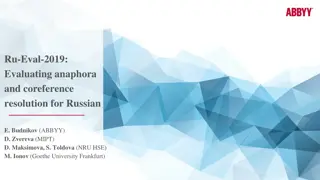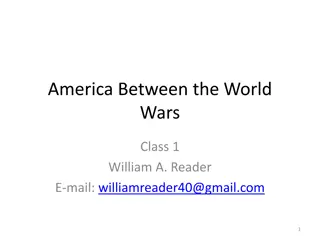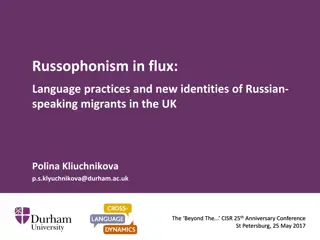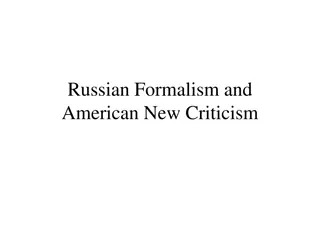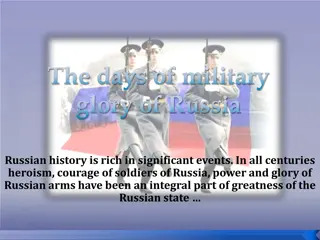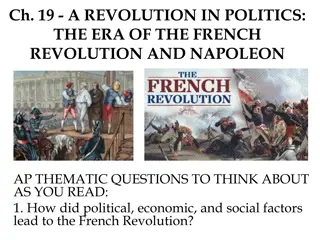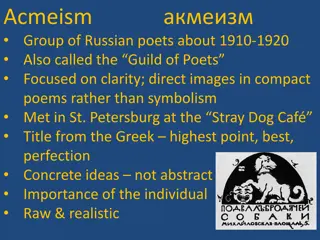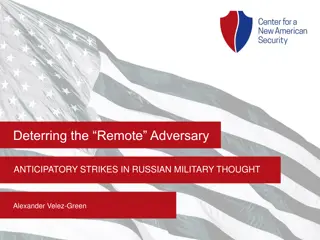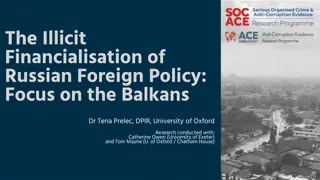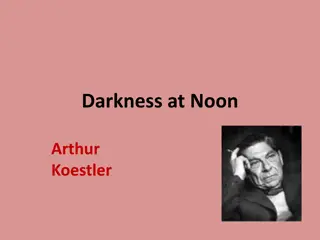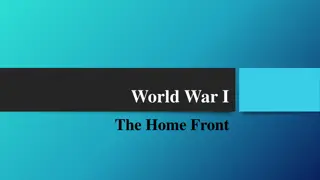Overview of the Russian Revolution and World War I
In this informative content, the Russian Revolution and World War I are explored in detail. Topics covered include the main causes of WWI, the phases of the Russian Revolution, the impact of World War I on Russia, and the consequences of the Russian Civil War. The content also delves into the pre-revolutionary state of Russia, the events leading to the revolution, and the aftermath of these historical events.
Uploaded on Oct 06, 2024 | 0 Views
Download Presentation

Please find below an Image/Link to download the presentation.
The content on the website is provided AS IS for your information and personal use only. It may not be sold, licensed, or shared on other websites without obtaining consent from the author. Download presentation by click this link. If you encounter any issues during the download, it is possible that the publisher has removed the file from their server.
E N D
Presentation Transcript
WWI Review: 1. Who fought who? (Countries for Central and Allied Powers) Central Powers: Germany, Austria-Hungary, Bulgaria, Ottoman Empire Allied Powers: Great Britain, France, Russia, Italy eventually the U.S. 2. What were the four MAIN causes of WWI? Militarism, Alliances, Imperialism, Nationalism 3. What sparked WWI? Assassination of Archduke Francis Ferdinand 4. How did the British plan to help the Russians? Did this plan work? Battle of Gallipoli-Huge Failure
Review Concept: TOTAL WAR The effects of Industrialism Men drafted into the armed forces Women work in the factories All resources of a nation go towards the war effort The entire nation seen as the enemy
Essential Questions: What were the three separate (but related) phases of the Russian Revolution? How did the outcome of these three events lead to an all out Russian Civil War? What were the consequences of the Russian Civil War?
Pre-Revolutionary Russia Only true autocracy left in Europe No type of representative political institutions Nicholas II became Tsar in 1884 Believed he was the absolute ruler anointed by God Russo-Japanese War (1904)
Phase One: The Revolution of 1905 Bloody Sunday-Czar s troops shot unarmed strikers on their way to deliver a petition October Manifesto-granted individual liberties and . Duma- Russia parliament/ legislative body (1906) Czar not removed: Army remained loyal French loaned money to Russia Revolutionary groups were deeply divided on goals
Conservatism Continues: 1905-1917 Tsar paid no attention to the Duma Duma was harassed and political parties were suppressed Nicholas was personally a very weak man Tsar became even more out of touch with peasantry
World War I 1914-1918 Russian death estimates are near 1.7 million people Most died on the battlefield A large number died because of disease and famine like conditions The government was simply unable to cope with this new kind of war
Phase Two: The March Revolution 1917 Origins: Food riots and strikes Duma declared itself a Provisional Government on March12th Tsar abdicated on March 17th Alexander Kerensky was the new leader Very Popular Revolution The Petrograd Soviet (council) of Workers and Soldiers
Review: What happened during the first two phases of the Russian Revolution? Phase One Creation of the Duma (1905) Czar still in power Phase Two March Revolution (1917) Czar steps down from power (abdicates) New Provisional government
Petrograd Soviets -Considered themselves socialists Social Democratic Party (SDP)-Divided into two radical directions Bolsheviks Bolsheviks Mensheviks Mensheviks Originally in control of the provisional government Major weakness: they wanted to continue WWI More Conservative Vladimir Lenin peace, bread, land Marxist Revolutionary socialist
Third Phase: October Revolution Took place on November 7, 1917 (called October because of the difference in the Russian Calendar) Lenin and the Bolsheviks overthrew the provisional government Bolsheviks renamed themselves the Communist Party
Peace from WWI to Civil War Treaty of Brest Litovsk- 1918 peace treaty Lenin s new government signed with the Central Powers Opponents of Lenin fought back by starting a civil war Reds (Lenin and the Communists) vs. Whites (right winged, counterrevolutionaries) To prevent any chance of the monarchy coming back to power, the communists executed the czar and his entire family The Allies sent troops to Russia to support the Whites By1922, the Communists won renaming Russia the Union of Soviet Socialists Republics..aka The Soviet Union
